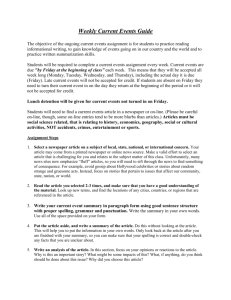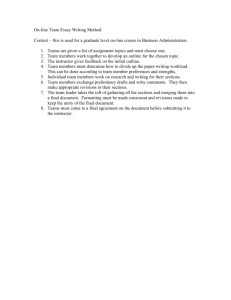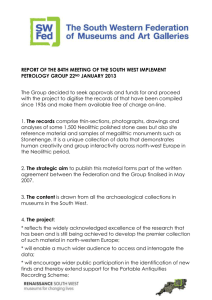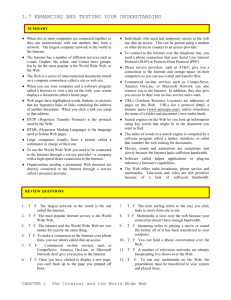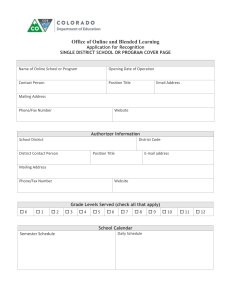MANAGING ORGANIZATIONAL CHANGE
advertisement
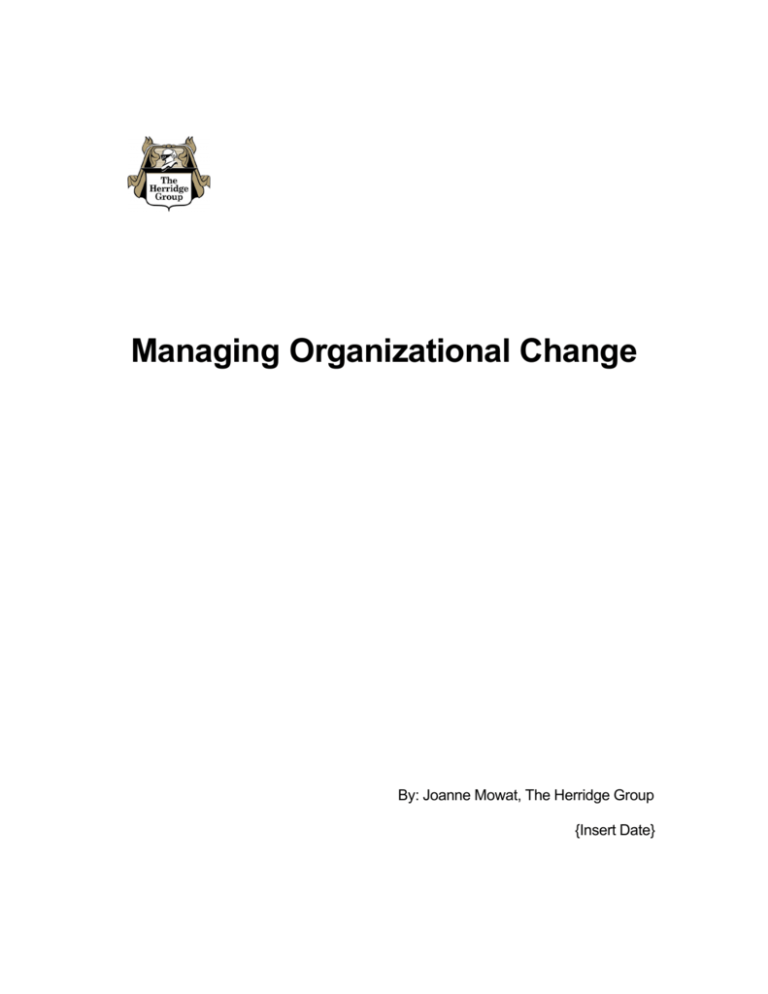
Managing Organizational Change
By: Joanne Mowat, The Herridge Group
{Insert Date}
Managing Organizational Change
Abstract
As the Greek philosopher Heraclitus (525 – 475BC) pointed out: change alone is
unchanging. Nowhere is this more true than in corporate North America.
Globalization; quantum leaps in technology; mergers and acquisitions; shifting
markets and client demands; and, significant changes in the workforce make
changing to survive a strategic imperative. All organizations need to have a
greater reach, be in more places, be aware of regional and cultural differences,
and integrate coherent strategies for different markets and communities. (Kanter,
1999) Failure to change, to change rapidly enough, or to make the right
changes, has turned corporate giants into subsidiaries, seemingly overnight.
With change having been a constant for over 2500 years, why are businesses
still so bad at managing it? Why do so many change initiatives wither and die
leaving only confusion and mangled processes in their wake?
This paper explores some of the reasons corporate change programs fail and
offers some ideas as to how a corporation can institutionalize change to become
a constantly evolving success story.
09/03/2002
2
Managing Organizational Change
Why Organizations Change
Organizational change (change at the enterprise-wide level) is provoked by a
major outside driving force that will cause an evolution to the next level in the
corporate life cycle. (McNamara, 2001) In broad terms, either inspiration or
desperation in the face of globalization, consolidation, technology, or legislation
force an organization to change in order to survive. It is rare for a business to
carefully plan and execute organizational change before an external or fiscal
reality forces the change. Change is hard work and it is almost always reactive.
What can be proactive is how an organization deals with a change situation and
how the organization prepares itself to identify and integrate change on an ongoing basis.
Enterprise-wide change is undertaken as a matter of survival. It is not an option
and it is not a whim. Change carries high costs in terms of human and physical
resources, share prices, stakeholder insecurity, customer dissatisfaction,
receivables and cash flow. “The reality is often a painful period of change, during
which resistance is high, morale is low, productivity is falling, and confusion is
rampant.” (Calvello & Seamon, 1995) No organization undertakes this lightly.
So, the question is, if the cause is just, the need is clear, the alternatives
evaluated, and the path to success communicated so that anyone in the
organization can see that the change is not optional but essential, why does the
change fail? The answer, “Just being right isn’t enough: you have to win the
hearts and minds of the people who will make the change happen.” (Marsh,
09/03/2002
3
Managing Organizational Change
2001) There is no disembodied organization that can be changed. Only the
people within an organization can make planned change a reality by changing
their behaviours and the ways they relate to one another.
Why Change Meets with Resistance
Implementing change in an organization forces people to alter how they relate to
one another. Not only do their goals, processes, equipment, and reality change
but the very way they deal with others in the organization changes. This causes
anxiety and anxiety causes resistance. “only people who instigate change enjoy
it; other have to suffer it.” (Marsh, 2001)
People trust the familiar and stick with strategies and behaviours, which have
been successful for them in the past. When the situation changes they will keep
applying these now inappropriate and ineffective behaviours and wonder why
they no longer work. In contrast, management is “convinced that once change is
fully established, the employees will automatically recognize its worth and
choose to embrace it.” (Gingerella, 1993) This is a terrible and costly
misconception.
Faced with forced change many employees feel threatened believing that they
will lose power, prestige, competence, and security. They feel that what is
happening is beyond their control, outside their sphere of influence, and they fear
09/03/2002
4
Managing Organizational Change
it. Depending on how the particular organization has managed past change, the
fears may be well grounded in experience.
Donald Kirkpatrick (1993) provides a comprehensive list of reasons why people
resist change. Because they:
•
fear losing their jobs, status, business contacts, or favorable working
conditions
•
don’t see a need for change
•
don’t like or respect the person or department that introduced the change
•
don’t like the way change was introduced
•
weren’t consulted or personally informed about the change
•
don’t understand the reasons for the change or feel it will do more harm
than good
•
consider the change a personal criticism
•
think that the change requires too much effort or comes at a bad time
•
think that the change creates more responsibility and work
•
want to test the organization to see if they can avoid implementing the
change
•
have negative feelings about the organization or their jobs
•
have been negatively influenced by their peers of the leaders of their peer
groups.
09/03/2002
5
Managing Organizational Change
All of these reactions can be managed and resistance overcome by focusing on,
and planning for, the human side of change. If employees perceive a loss of
identity, relationships, disorientation, or a risk of failure they will focus their
energy on coping with stress rather than on production and innovation. (Demers,
Forrer, Leibowitz, Cahill, 1996) Anything that is not understood will be perceived
as a threat as employees move into fight or flight mode. D’Aprix (1996) states
that the likely employee reactions to an announcement of major organizational
change will be:
•
15 percent angry;
•
40 percent fearful, skeptical, and distrustful;
•
30 percent uncertain but open; and,
•
15 percent hopeful and energized.
This means that 55 percent of the organization is against the change and 85
percent are not ready to wholeheartedly commit their energies to what needs to
get done. Without employee commitment the change will not happen.
How can resistance become acceptance? It all comes down to trust and direct,
personalized communication early and often. “It is not that people cannot cope
with changes to their working environment – it is the way in which these changes
are communicated that cause resistance.” (Marsh, 2001) Employees need to
know what is expected of them, they need to believe that what they want and do
are important, they need to know how to contribute and become involved, and
09/03/2002
6
Managing Organizational Change
they need to hear this at a time they are ready to hear it and in a format that
makes sense to them. (Frady, 1997) Practical, direct, honest communication.
The Change Process: Phases of Change
There are many change models available seeking to clarify and define the
process of change at a human behaviour level. The Change Curve, below, offers
a clear, concise picture which has successfully helped many of my clients begin
to understand and deal with change. It also provides an easy, clear language
they can use to discuss change in a non-threatening, process-based manner.
This helps take personalities and personal biases out of the picture and
reinforces that all the stages of change are normal.
This model lets one frame change. It can be used to illustrate that people react
differently to change based on:
•
Personal change tolerance;
•
The number of changes going on simultaneously in a person’s life;
•
How critical the person perceives each change to be; and,
•
How much change has happened over the past twelve to twenty-four
months.
This model is also effective in opening discussion on how one can help one’s
peers move through the phases, thus ensuring a successful change for the entire
group. Getting the group to take responsibility for moving all the members
09/03/2002
7
Managing Organizational Change
through the change, respecting each persons change parameters, and
understanding that no one really wants to be left behind.
The Change Curve
TRANSITION POINT
RESISTANCE
DENIAL
CHANGE BEGINS
EXPLORATION
COMMITMENT
CHANGE ADOPTED
Scott & Jaffe, Managing Organizational Change
*taken from Gingerella, 1993
As Gingerella (1993) points out, initial feelings of danger result from potential loss
of control, competence, direction, and territory. Once these issues are
addressed people can move into the opportunity phase and begin to see the
potential for greater freedom, power, recognition, increased participation and
reward.
09/03/2002
8
Managing Organizational Change
During denial typical thoughts include:
•
If I just ignore this it will go away
•
This must be a mistake
•
This must be going on in another department, my department is working
well
During denial, employees want to believe that the change is still optional,
probably a mistake, that it will go away and life will get back to normal.
Communication and getting employees involved in the change will move them
quickly out of denial. It is important to reinforce that the change is required for
business survival, explain what factors are causing the change, focus on a clear
goal, and institute robust two-way communication to deal with issues and move
people out of the denial phase.
By the time people enter the resistance phase they are becoming angry and it is
anger based on fear. Typical thoughts include:
•
How could they do this to me
•
I’ll show them. They can’t make this work without me.
•
I’m just not going to do it
During this phase, if it is not managed well, sabotage of the process or even the
plant can occur. Employees who do not move out of this phase remain angry
and non-productive. They have a negative impact on those around them and
09/03/2002
9
Managing Organizational Change
often need to be removed from the organization. Resistance is a normal phase
that everyone passes through, it may take a minute or months. If resistance is
not dealt with, the organizational change will fail. During resistance
“Managers are faced with increasing absenteeism, failing
production, and decreasing quality. The employees begin to
coalesce into protective reinforcement groups, or worse, they
surrender to their fears and become organizational dropouts.”
(Gingerella, 1993)
In a healthy change initiative participants will move through resistance, reach a
transitional point and begin to identify personal opportunities to flourish based on
the change. First, employees become willing to explore the change and look for
ways they can contribute. This is a very fragile period. Communication and
personal reinforcement must be maintained and managed. Employees must be
rewarded for even small increments of involvement. During exploration comfort
zones are being rebuilt and existing skills are being applied to new and
challenging tasks, relationships and processes. Any failure to support the
employee during exploration will result in an immediate and final retreat into
resistance or indifference.
A successful journey through exploration will lead employees to commitment and
change adoption and integration into the organization. Commitment comes
through transition. As Bridges and Mitchell (2000) point out, change is external,
09/03/2002
10
Managing Organizational Change
transition is the internal psychological reorientation employees experience which
allows the change to work.
While these phases appear to be linear they are actually iterative with slight
movement into and out of each phase as people put a tentative foot forward,
retreat slightly, and make a larger foray. How the organization communicates,
rewards, and supports the iterations will determine whether change is successful.
Engineering Successful Change
Continuous and overlapping change has become a way of life in the corporate
environment. (Conner, 2001) In the 1980’s change theories recommended
unfreezing, changing, then refreezing the organization. The refreezing part of
this equation is no longer possible. There is no new status quo just continuous
evolution and change in response to competition and markets. This speed of
change has introduced a new desirable employee characteristic: resilience or the
ability to manage one’s energies, support the change, and emerge stronger than
before the change.
Employee Resilience
Resilience is the ability to move through a change and come out stronger than
before with enough personal energy in reserve to still get the job done. Part of
building employee resilience is helping them learn how to say goodbye to the old
way of doing things, the way of doing things which, in the past, made them
09/03/2002
11
Managing Organizational Change
successful. Next, acknowledge the neutral zone, the period of time during which
people are focusing their energies on coping with the uncertainties and
confusion. Then help employees move forward. There is a natural tendency to
hang back and see how others handle the new beginning. (Bridges and Mitchell,
2000) Foster resilience by providing safe environments for risk taking,
rewarding large and small successes, and informing everyone but only pulling on
the energies of those required for that portion of the change. Save some
employee energy for later – you will need it!
Change Leadership
Leadership is the other key component of successful change. As Kanter (1999)
points out “the most important things a leader can bring to a changing
organization are passion, conviction, and confidence in others.” Successful
change leaders focus on the change and solely on the change. It must the
centre of all thoughts and actions and the driving force behind business
decisions.
Change is messy, chaotic, and turbulent. It is not a neat process – the plan will
not go smoothly. Change leaders must be willing to:
•
Listen to the corporate environment by developing a network of contacts
that will keep them honestly and completely informed. This ties in with
building coalitions, groups of key supporters and influencers with the same
drive and vision as the leader. Use this network to understand why some
09/03/2002
12
Managing Organizational Change
employees are not embracing the change and take steps to help those
employees.
•
Search for agreements between the leader and the opposition and use
these agreements to lure the opposition into the fold.
•
Challenge the prevailing corporate wisdom. Kill the corporate sacred
cows. Assumptions must be challenged and often discarded. Problems
must be considered from new angles. However, only disrupt what needs
to be changed. Retain the best of what is already being done, if it fits with
the new vision.
•
In creating a change plan, consider the degree of resistance to be
expected, the target population, the stakes, the time frame, the available
expertise, and the level of dependency between management and
employees.
•
Establish parameters and define the limits of the change.
•
Communicate in clear terms the 4 Ps of change: the purpose, the picture,
the plan, and the part. Why is the change being implemented, what will
the final state look and feel like, how can we get there, and what does
each individual need to do to help the corporation get there. Be open and
honest. Do not pretend that the negative aspects of the change do not
exist.
•
Give ownership for the change to the people who are ultimately
responsible for its success. Involve those who need to be involved.
Clearly define the roles they will play in the change, their goals, and how
09/03/2002
13
Managing Organizational Change
success will be recognized (how will we know when we get there). Make
sure to track, support, reward, and challenge their ideas.
•
Remember that they took some time to come to grips with the change and
that they probably took less time that most others in the organization will
need. Understand that others will need time to change.
•
Recognize their own limitations and the effect these could have on the
changing organization.
•
Realize that in most cases the change will:
o Take longer than anticipated
o Come up against unforeseen problems
o Regularly become uncoordinated and ineffective and need an
adjustment
o Fall short of forecasts
o Lose momentum
Design flexibility into the change process. Do not redirect the course too quickly.
Persevere.
(Kanter, 2001) (Nickols, 2000) (Bridges and Mitchell, 2000) (MacAdam, 19971998)
Quantum and Incremental Change
Few would argue that systemic analysis will result in a more business focused,
communicable end-state vision. Much discussion is generated as to whether that
09/03/2002
14
Managing Organizational Change
systemic vision must be implemented simultaneously throughout the entire
organization.
There was a time, or so I have been told, when leaders could order a change and
sit back and wait while the change was implemented throughout the organization.
If that time did indeed exist it is a time long gone. Organizations are far too large
and far too complex with a mirage of variables which cannot be controlled from
the centre. Today, “quantum change occurs incrementally -- as a result of “high
leverage” decisions and actions that push the organization in new directions and
reverberate and cumulate in their effects.” (Morgan and Zohar, 1996) Gareth
Morgan’s 15% Solution theory states that most people have about 15 percent
control over their work situations. If individuals target doable, high leverage,
actions in their locus of control, and if these actions are in the direction of the
required corporate change, then incremental change spreads throughout the
organization based on realistic changes owned by the people who can make the
change succeed.
Dramatic change fizzles out while incremental change embeds itself in the fabric
of the continuously improving organization. Breakthrough ideas and pivotal
changes can generate large effects; critical mass is achieved through
incremental change building momentum and fostering innovative actions around
a shared vision.
09/03/2002
15
Managing Organizational Change
Conclusion
“Change unfolds. It can be nudged and shaped, but never fully programmed and
controlled.” (Morgan and Zohar, 1996)
As such the phrase change
management is an oxymoron. One cannot manage change but one can work to
institutionalize resilience and continuous change in an organization. Rather than
periodically mobilizing enormous corporate energies to implement a change
program, change should be a matter of the daily work of each person in the
organization.
By constantly scanning the economic horizon and communicating trends and
opportunities, leaders can provide line personnel with the information they need
to inspire employees to continuously, and incrementally, shift and shape the
organization in productive and profitable directions. Organizational flexibility is
increased making it possible to react quickly and more effectively should a large
scale, quantum change be required.
Leaders need to identify the business imperative, communicate the vision,
establish the parameters, and create a supportive environment which fosters
incremental change toward the goal. Front line supervisors need to
communicate and clarify the goal consistently and constantly in terms that
employees can operationalize. It is to these front line managers that the task of
helping employees move from denial to commitment falls.
09/03/2002
16
Managing Organizational Change
Employees need to identify opportunities, within their sphere of influence, to
move the organization towards the goal and to build flexibility into processes to
allow for on-going change. If the organization fails so do the employees.
Working together these human components of the corporation can build a
healthy and profitable enterprise able to adjust and reposition as technology,
globalization, mergers and acquisitions, shifting markets, and customer
requirements continuously change.
09/03/2002
17
Managing Organizational Change
References
•
Addison, Roger M. and Lloyd, Clayton R. (1999, July). Implementation: The
Glue of Organizational Change. Performance Improvement, v38 n6 pp 8-11.
•
Breen, Bill and Dahle Cheryl. (1999, December). 20/20 Change Agent. Fast
Company [on-line]. Available: www.fastcompany.com/online/30/toolbox5.html.
•
Bridges, William and Mitchell, Susan. (2000, Spring). Leading Transition: A
New Model for Change. Leader to Leader [on-line]. Available:
www.pfdf.org/leaderbooks/121/spring2000/bridges.html.
•
Calvello, Mike and Seamon, Dan. (1995, April). Change Management
Through Transition Teams: The Carolina Power & Light Solution.
Performance Improvement, v34 n4 pp 16-19.
•
Clark, Don. (1997, March). Reflecting on Change [on-line]. Available:
www.nwlink.com/~donclark/leader/change1.htm.
•
Connor, Daryl R. (1994, September). Bouncing Back. Delta SKY Magazine
[on-line]. Available: www.odrinc.com/inter/news/delta.html
•
D’Aprix, Roger. (1996). Communicating for Change – Connecting the
Workplace with the Marketplace. San Francisco: Jossey-Bass.
•
Demers, Russ, Forrer, Stephen E., Leibowitz, Zandy and Cahill, Cindy. (1996,
August). Commitment to Change. Training & Development, v50 n8 pp 22 26.
•
Frady, Marsha. (1997, August). Get Personal to Communicate Coming
Change. Performance Improvement, v36 n7 pp 32-33.
•
Gingerella, Leonard F. (1993, December). Moving From Vision to Reality:
The Introduction of Change. Performance Improvement, v32 n10 pp 1-4.
•
Hume, Jay Huntingdon. (1994, January). The Requirements of Real
Organizational Change. Performance Improvement, v33 n1 pp 25-26.
•
Kanter, Rosabeth Moss. (1999, Summer). The Enduring Skills of Change
Leaders. Leader to Leader [on-line]. Available:
www.pfdf.org/leaderbooks/121/summer99/kanter.html
•
Kirkpatrick, Donald L. (1993, February). Riding the Winds of Change. Training
& Development, v47 n2 pp 28 - 32.
09/03/2002
18
Managing Organizational Change
•
MacAdam, Millard Dr. (1997-1998). Orchestrating Successful Organizational
Changes [on-line]. Available: www.mbsnet.com/lbchange.htm.
•
Malott, Maria E. (1999, February). Crating Lasting Organizational Changes.
Performance Improvement, v38 n2 pp 33-36.
•
Marsh, Christine. (2001, March). Degrees of Change – Resistance or
Resilience. Performance Improvement, v40 n3 pp 29-33.
•
Marshall, Jay and Conner, Daryl R. (1996, First Quarter). Another Reason
Why Companies Resist Change [on-line]. Available: www.strategybusiness.com/briefs/96101/
•
McNamara, Carter. (2001). Basic Context for Organizational Change [on-line].
Available: www.mapnp.org/library/mgmnt/orgchnge.htm.
•
Morgan, Gareth. (1996, October). Creating Quantum Change [on-line].
Available: www.imaginiz.com/speeches/quantum.html.
•
Morgan, Gareth and Zohar, Asaf. (1996, October). Achieving Quantum
Change: Incrementally!! The Art of High Leverage Change [on-line].
Available: www.yorku.ca/faculty/academic/gmorgan/0695home.html
•
Morgan, Gareth and Zohar, Asaf. (1996, October). Key Principles for
Managing Change (7/7) [on-line]. Available:
www.yorku.ca/faculty/academic/gmorgan/0695keys.html.
•
Mourier, Pierre. (2000, November/December). Goal Translation: How to
Create a Results-Focused Organizational Culture. Performance
Improvement, v39 n10 pp 15-24.
•
Murphy, John R. (1997, May). Change Second. Training & Development, v34
n5 pp 58 - 67.
•
Nauheimer, Holger. (2001). Change Management Toolbook [on-line].
Available: home.snafu.de/h.nauheimer/intro.htm.
•
Neur, Lara H. (1999, November/December). Learning as Leadership: A
Methodology for Organizational Change Through Personal Mastery.
Performance Improvement, v38 n10 pp 9-13.
•
Nickols, Fred. (2000). Change Management 101 A Primer [on-line]. Available:
www.home.att.net/~nickols/change.htm.
09/03/2002
19
Managing Organizational Change
•
Slobodnik, Alan J. and Slobodnik, Deborah. (1998, April). Change
Management in a Human Systems Model: Four System Types [on-line].
Available: www.optionsfc.com/FedPress.htm.
•
Stiegelbauer, Suzanne M. (1994, September). Change has Changed:
Implications for Implementation of Assessments from the Organizational
Change Literature. Systemic Reform: Perspectives on Personalizing
Education [on-line]. Available:
www.ed.gov/pubs/EDReformStudies/SysReforms/stiegel1.html.
•
Tosti, Donald T. (2000, March). Systemic Change. Performance
Improvement, v39 n3 pp 53-59.
•
Weinstein, Jay. (1997). Social and Cultural Change. United States: Allyn &
Bacon.
•
Wharton and Roi. (2001). You Can’t Get There from Here: Why Structural
Changes Won’t Cut It [on-line]. Available:
www.wiseleadership.com/structure.html
09/03/2002
20




